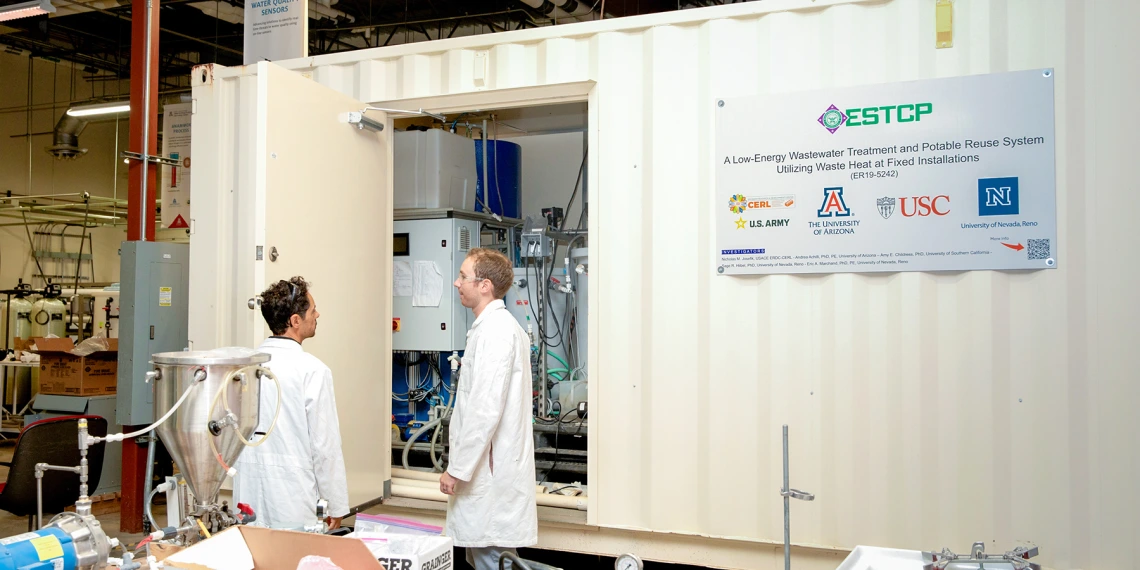WEST–ERDC partnership propels water reuse for national security

Andrea Achilli (left) and Luke Presson (right) at the ESTCP Demonstration Project semi-portable, containerized advanced water purification unit.
Leslie Hawthorne Klingler
Tucson, AZ — WEST’s expanding partnership with the U.S. Army Engineer Research and Development Center (ERDC) is driving new research on practical water reuse solutions for both military and civilian communities. “Water reuse is, of course, an important response to water scarcity,” says Andrea Achilli, principal investigator for two of the center’s largest current grants, “but we can’t forget it’s also about national security.”
“Water reuse is, of course, an important response to water scarcity,” says “but we can’t forget it’s also about national security.” — Andrea Achilli, associate professor of chemical and environmental engineering
Achilli, associate professor of chemical and environmental engineering, leads the U of A’s work in a four-year, $38M ERDC-funded Water Reuse Consortium—which also includes the University of Southern California and the University of Nevada–Reno. The U of A’s $10M portion of the grant supports research on smart treatment systems, sustainable brine management technologies, and improved virus detection. It also invests in training and public engagement to encourage wider adoption of water reuse.
In 2024, the U of A and ERDC strengthened ties further by signing an Educational Partnership Agreement, enabling WEST to host postdoctoral researchers at its facilities. The first to participate, Luke Presson—an ORISE scientist with the Army Corps of Engineers—conducts research and connects partners across the Consortium to align its work with military needs. “This partnership shows how the federal government and universities can work together to advance the research and better the nation. Using both of our strengths we can accomplish so much more than going at it alone. We hope this EPA is an example that we can replicate at other universities,” said Nicholas Josefik, Presson’s supervisor at the U.S. Army Engineer Research Development Center.
One area of investigation where Achilli and Presson see big potential benefits is moving communities from massive water and wastewater treatment plants to smaller, mobile and semi-mobile advanced water purification systems.
One area of investigation where Achilli and Presson see big potential benefits is moving communities from massive water and wastewater treatment plants to smaller, mobile and semi-mobile advanced water purification systems. Traditional facilities are costly, built to last decades, and risky to upgrade. In contrast, decentralized systems are easier to adapt. For forward operating military bases, on-site reuse—particularly processes using only electricity, without chemicals—could reduce the dangers of resupply missions. For civilian communities, these smaller systems would lessen dependence on large, centralized plants that leave entire communities vulnerable if they fail.
These concepts have already been put to the test through an earlier ERDC-funded effort, the ESTCP Demonstration Project. Completed in 2025, the project piloted a semi-portable, containerized advanced water purification unit.
The system performed well during trials at WEST and Tucson’s Tres Rios Water Reclamation Facility, but when deployed to Fort Huachuca it clogged due to excess solids in the water. Presson said the challenge was disappointing but they were glad it showed up during testing.
“It’s better to find out that the system needs a simple mechanical screen before it’s sent to a forward operating base that’s relying on it to work,” he said. “That’s why what WEST does is so important.”
See also: Collaborations at the WEST Center drive innovation and national recognition

